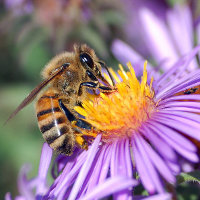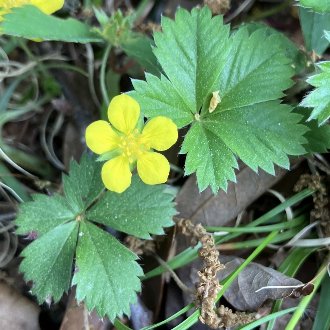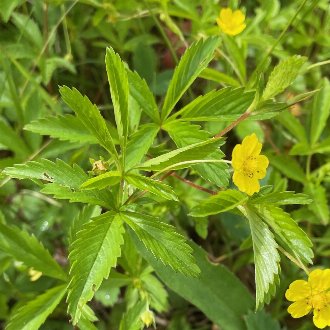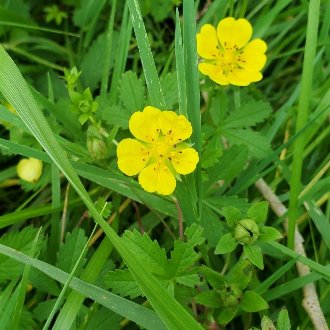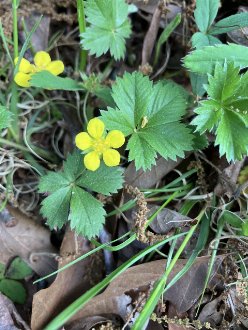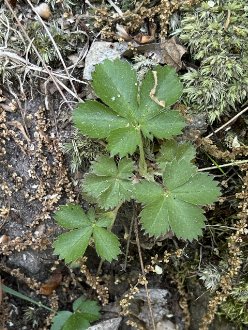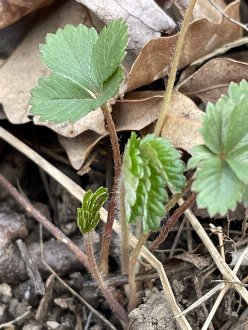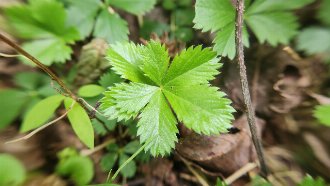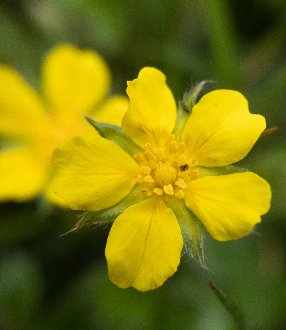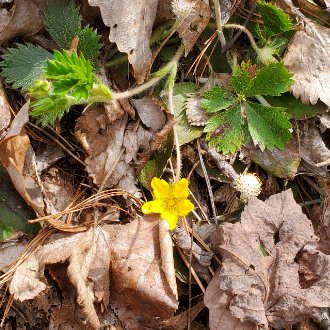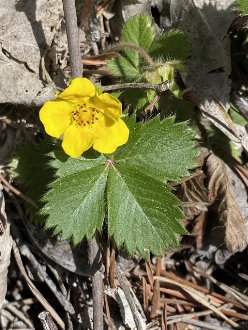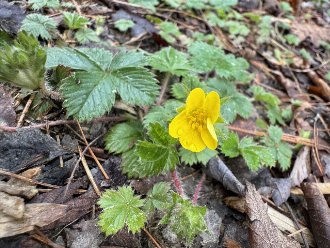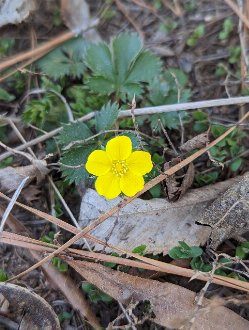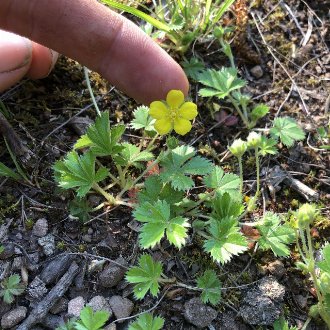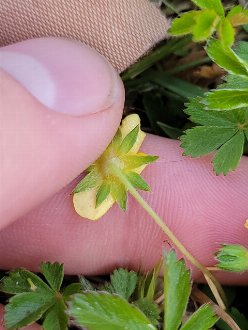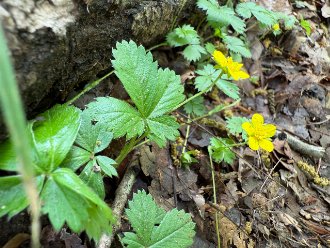Dwarf Cinquefoil (Potentilla canadensis L.)
Also known as running five-fingers, dwarf potentilla, old-field cinquefoil.
↑Summary
A native, creeping perennial of Eastern North America, occurring on dry to mesic, lightly-shaded sites with acidic soil.
↑Range - Expand
| Legend | Color |
| Native | |
| Native or Not Present |
This map is based on our research. We have checked its accuracy to Level 3 ecoregions. Although this plant occurs somewhere in each of these regions, it may only occur in a small part of some or all of them.
This species is rare and scattered in many of the ecoregions around the border of its range, although it also may be underreported as it is difficult to identify and frequently confused with P. simplex.
↑Similar Plants
↑Habitat
Dwarf cinquefoil occurs in a variety of dry to mesic habitats, usually in partial sun to light shade, usually on acidic soil of low fertility. Natural habitats include dry meadows, savannas, woodland borders and clearings, especially of oak and/or conifer forests, and open rocky woods. Anthropogenic habitats include lawns, roadsides, and pastures or abandoned fields especially where soil is dry and acidic. It is often most common on disturbed sites, but it can occur in more stable barren sites such as shale barrens, where erosion creates disturbance on an ongoing basis, sites that burn regularly, or sites where rock outcroppings limit soil accumulation.
It tolerates a range of soil textures, including clay, loam, silt, sand, rocky or gravely soils. It requires good drainage, so on clay soils or thin soils over impermeable bedrock it is limited to slopes with good topographic drainage, whereas it can occur on flat sites on well-drained soils. It is often abundant on soils derived from chert, sandstone, or shale, but it occurs on soils derived from many other materials as well.
Dwarf cinquefoil prefers partial sun to light shade cast by an open tree canopy, but it has low tolerance for ground-level competition. It can survive regular mowing, and can become a dominant plant in dry parts of untreated lawns on acidic soils. It can survive in lawns on slightly richer sites than it would occur on naturally, as mowing removes taller vegetation that would normally outcompete it.
It is found both on sites that burn and those that do not, but it tends to benefit from fire, especially fire that removes competing herbaceous vegetation and restricts the tree canopy to species that cast only lighter shade.
↑Life Cycle
Dwarf cinquefoil is a low-growing, creeping perennial that reproduces both vegetatively and by seed.
Plants form a stout taproot and grow basal leaves, and then grow a stem (stolon) that initially grows upright but soon leans or trails on the ground. The growth rate is slow and not usually sufficient to keep pace with competing vegetation other than moss or sparse, low grasses. The stem is usually unbranched, and will root at some nodes as it finds suitable conditions. In this manner the plant reproduces vegetatively.
Established plants flower in spring; first-year plants do not necessarily flower. The growth rate is variable mostly as a function of light.
Foliage is semievergreen in much of its range, evergreen on warm sites and in the south of its range, and deciduous in the north of its range and in cold and/or dry winters.
Healthy plants are fairly resistant to top-kill and will resprout following any disturbance that removes the leaves.
We could not find information on the typical lifespan of this plant. The lifespan of individual plants is likely highly variable; vegetative colonies can often live for a long time even when individual ramets (cloned plants) are short-lived. Plants are probably longer-lived when they occur in more stable habitats, such as dry shady slopes with poor soil, and shorter-lived on more dynamic sites where this species colonized in response to disturbance.
Competition or shading from other plants is typically the main cause of mortality of this plant, but it also can be killed by flooding or waterlogging when it temporarily colonizes sites during a dry year.
↑Faunal Associations
We found several casual sources saying that this plant is widely eaten by rabbits and groundhogs, but is resistant to deer browsing, but we have been unable to verify these claims in more scientific sources. The leaves are pressed tightly against the ground and are likely harder for herbivores to browse on than the other, more upright Potentilla species, and they also tend to be tougher and hairier on average.
Birds eat the seeds to a degree; although we could not find information specific to this species, many Potentilla species have seeds that pass through the digestive tracts of mammalian herbivores undigested, helping to spread them to new areas. The location and appearance of the seed clusters, near the leaves, slightly elevated, but inconspicuous and surrounded by more conspicuous leafy bracts and sepals, is consistent with this species relying on mammalian herbivores unintentionally eating its seeds.
We could not find an exhaustive study of the insects supported by this plant, but it tends to support a lot of insects relative to its size.
In the north of its range, the larvae of the northern grizzled skipper (Pyrgus centaureae) eat this plant; the adult lays eggs on it in May, and the larvae develop very slowly so that they are able to continue eating the plant as it develops, not pupating until late August. As that skipper is endangered in parts of its range and this plant is an important food source, protecting populations of this plant has been pointed to as a key part of protecting that skipper. The rush veneer (Nomophila noctuella) also eats this plant, among others.
The cinquefoil bud gall wasp (Diastrophus potentillae) forms galls on the stems of this and common cinquefoil (Potentilla simplex), and the larvae of the gall wasp Diastrophus niger forms galls on petioles and leaflet midribs. The aphid Anthracosiphon crystleae also feeds on the sap from the stolons.
↑Links & External Resources
• Potentilla canadensis (dwarf cinquefoil) | USDA PLANTS Database (About This Site)
• Potentilla canadensis | Go Botany (About This Site)
• Dwarf Cinquefoil | iNaturalist (About This Site)
• Potentilla canadensis | Biota of North America Project (BONAP) (About This Site)
• Potentilla canadensis | NatureServe Explorer (About This Site)
• Potentilla canadensis | Flora of North America (About This Site)
• Potentilla canadensis | Missouri Plants (About This Site)
• Dwarf Cinquefoil | Maryland Biodiversity Project (About This Site)
• Potentilla canadensis L. (Dwarf Cinquefoil, Canada Cinquefoil) | Digital Atlas of the Virginia Flora (About This Site)
• Potentilla canadensis L. | Plants of the World Online (POWO) (About This Site)

